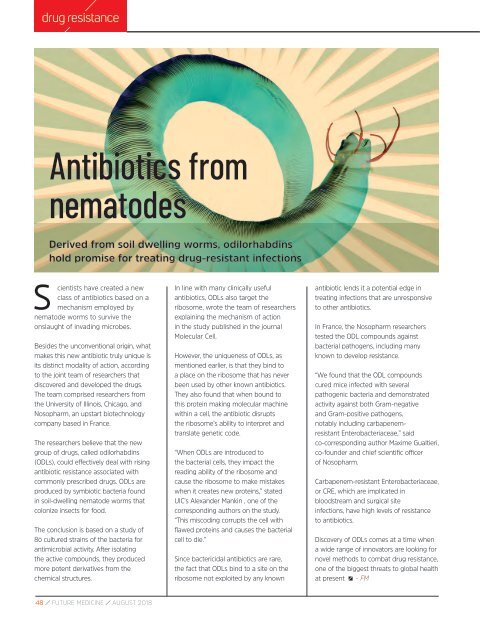FM AUGUST 2018 ISSUE1 - digital edition
Create successful ePaper yourself
Turn your PDF publications into a flip-book with our unique Google optimized e-Paper software.
drug resistance<br />
Antibiotics from<br />
nematodes<br />
Derived from soil dwelling worms, odilorhabdins<br />
hold promise for treating drug-resistant infections<br />
S<br />
cientists have created a new<br />
class of antibiotics based on a<br />
mechanism employed by<br />
nematode worms to survive the<br />
onslaught of invading microbes.<br />
Besides the unconventional origin, what<br />
makes this new antibiotic truly unique is<br />
its distinct modality of action, according<br />
to the joint team of researchers that<br />
discovered and developed the drugs.<br />
The team comprised researchers from<br />
the University of Illinois, Chicago, and<br />
Nosopharm, an upstart biotechnology<br />
company based in France.<br />
The researchers believe that the new<br />
group of drugs, called odilorhabdins<br />
(ODLs), could effectively deal with rising<br />
antibiotic resistance associated with<br />
commonly prescribed drugs. ODLs are<br />
produced by symbiotic bacteria found<br />
in soil-dwelling nematode worms that<br />
colonize insects for food.<br />
The conclusion is based on a study of<br />
80 cultured strains of the bacteria for<br />
antimicrobial activity. After isolating<br />
the active compounds, they produced<br />
more potent derivatives from the<br />
chemical structures.<br />
In line with many clinically useful<br />
antibiotics, ODLs also target the<br />
ribosome, wrote the team of researchers<br />
explaining the mechanism of action<br />
in the study published in the journal<br />
Molecular Cell.<br />
However, the uniqueness of ODLs, as<br />
mentioned earlier, is that they bind to<br />
a place on the ribosome that has never<br />
been used by other known antibiotics.<br />
They also found that when bound to<br />
this protein making molecular machine<br />
within a cell, the antibiotic disrupts<br />
the ribosome’s ability to interpret and<br />
translate genetic code.<br />
“When ODLs are introduced to<br />
the bacterial cells, they impact the<br />
reading ability of the ribosome and<br />
cause the ribosome to make mistakes<br />
when it creates new proteins,” stated<br />
UIC’s Alexander Mankin , one of the<br />
corresponding authors on the study.<br />
“This miscoding corrupts the cell with<br />
flawed proteins and causes the bacterial<br />
cell to die.”<br />
Since bactericidal antibiotics are rare,<br />
the fact that ODLs bind to a site on the<br />
ribosome not exploited by any known<br />
antibiotic lends it a potential edge in<br />
treating infections that are unresponsive<br />
to other antibiotics.<br />
In France, the Nosopharm researchers<br />
tested the ODL compounds against<br />
bacterial pathogens, including many<br />
known to develop resistance.<br />
“We found that the ODL compounds<br />
cured mice infected with several<br />
pathogenic bacteria and demonstrated<br />
activity against both Gram-negative<br />
and Gram-positive pathogens,<br />
notably including carbapenemresistant<br />
Enterobacteriaceae,” said<br />
co-corresponding author Maxime Gualtieri,<br />
co-founder and chief scientific officer<br />
of Nosopharm.<br />
Carbapenem-resistant Enterobacteriaceae,<br />
or CRE, which are implicated in<br />
bloodstream and surgical site<br />
infections, have high levels of resistance<br />
to antibiotics.<br />
Discovery of ODLs comes at a time when<br />
a wide range of innovators are looking for<br />
novel methods to combat drug resistance,<br />
one of the biggest threats to global health<br />
at present - <strong>FM</strong><br />
48 / FUTURE MEDICINE / <strong>AUGUST</strong> <strong>2018</strong>


















